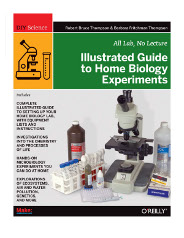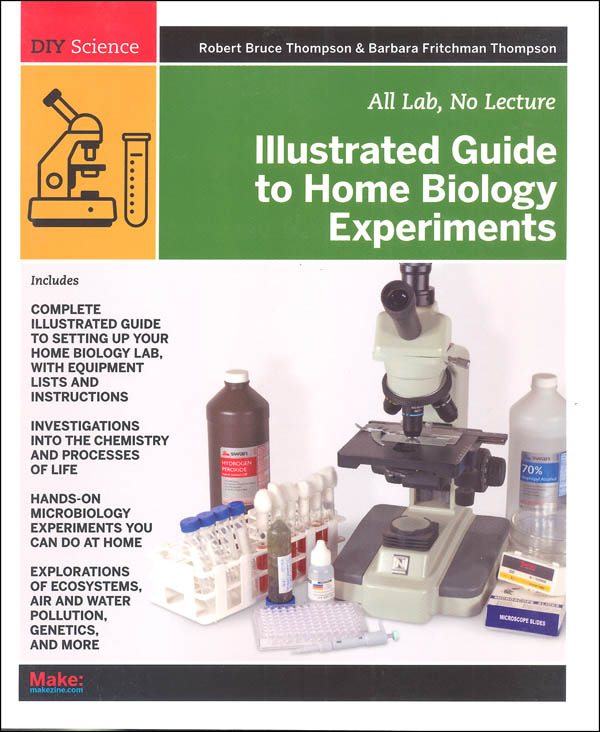A few years ago I wrote up a very favorable review of Robert Bruce Thompson's Illustrated Guide to Home Chemistry Experiments, so I was interested in checking out his similar book for biology. Illustrated Guide to Home Biology Experiments is similar in concept and design to the chemistry book, so you can check out that review for the basics.
The Illustrated Guide to Home Biology Experiments has 30 experiments, including some that are especially pertinent to modern science such as "Extracting, Isolating, and Visualizing DNA" and "Investigating Bacterial Antibiotic Sensitivity." The book begins with an extensive section on setting up your home laboratory, including information about microscopes, equipment, specimens, and other supplies. Thompson has tried to create experiments that are safe to do at home and that require only inexpensive equipment and supplies aside from a good microscope. He also wanted this to be a rigorous lab course that covered basic experiments for a high school course while also offering an interesting option for the do-it-yourselfer who wants to learn the "fundamentals of biology lab work" (p. xi). In addition to the labs topics mentioned above, experiments range over a breadth of topics such as observing microcosms, investigating Protista, investigating seed plants, air pollution testing, exploring genetics, and investigating vertebrate tissues. There are no dissections of specimens like worms or eyeballs.
Labs will correlate with most biology textbooks including those from Apologia, BJU Press, and A Beka, plus CK-12 Biology (free biology text with teacher's guide, quizzes, tests, worksheets, and answer keys), and Miller-Levine Biology (Pearson).
Some people are likely to be put off by the dedication of this book to Charles Darwin, "the towering genius whose theory of evolution is the foundation of modern biology." An evolutionary perspective underlies this entire course, showing up in mentions of common descent and other brief explanatory material. But it is presented in such a way that those who disagree with the theory of evolution should still be able to work with it.
This is a very thorough lab manual that offers safety cautions and complete instructions for using equipment and materials along with step-by-step instructions for each lab. Labs are more involved and demanding than those in many other high school biology courses for homeschoolers that I have reviewed. Some students might be able to work through the labs without adult supervision, but it is best if a parent or teacher oversees lab activities. However, parents and teachers do not need to teach the labs, making this a good resource for parents with limited exposure to biology.
Students will need to create their own lab notebook following instructions in this section. There are no data recording pages in this book.
The manual is illustrated in full-color, a very helpful feature. Many of the labs have a number of investigations or multi-step investigations. Occasionally a lab will be dependent upon work done in a previous lab. Each lab concludes with a set of review questions. Students might print out and write answers on pages from the manual.
Interestingly, this 359-page lab manual is available as a free download. However, the answer key for the review questions is available on a DVD that comes free with the purchase of a lab kit or is available for separate purchase. The Home Scientist, LLC is really more interested in selling the kits. And it certainly makes sense if you choose to use this lab manual to buy the companion kit since it contains a very long list of equipment and supplies that you will need. You still need to purchase a microscope. You can prepare your own slides for viewing, but this is a hassle. While prepared slides are available they are quite expensive, so high-resolution images of the slides are available on the DVD. (Smaller, low resolution versions of these images are in the manual.)
The Illustrated Guide to Home Biology Experiments offers quality lab experience that should prepare students well for future studies and work in biological science fields.









